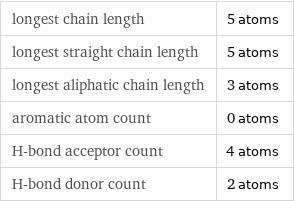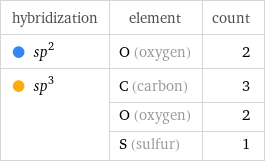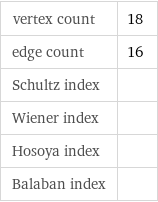Input interpretation

1 propanesulfonate hydrate
Basic properties

molar mass | 142.2 g/mol formula | C_3H_10O_4S empirical formula | O_4C_3S_H_10 SMILES identifier | CCCS(=O)(=O)O.O InChI identifier | InChI=1/C3H8O3S.H2O/c1-2-3-7(4, 5)6;/h2-3H2, 1H3, (H, 4, 5, 6);1H2/f/h4H; InChI key | ZOMVECCWOODHNF-UHFFFAOYSA-N
Structure diagram

Structure diagram
Quantitative molecular descriptors

longest chain length | 5 atoms longest straight chain length | 5 atoms longest aliphatic chain length | 3 atoms aromatic atom count | 0 atoms H-bond acceptor count | 4 atoms H-bond donor count | 2 atoms
Elemental composition

Find the elemental composition for 1 propanesulfonate hydrate in terms of the atom and mass percents: atom percent = N_i/N_atoms × 100% mass percent = (N_im_i)/m × 100% Plan: • Write the chemical formula and gather atomic masses from the periodic table. • Determine values for N_i, m_i, N_atoms and m using these items. • Finally, compute the percents and check the results. Write the chemical formula: C_3H_10O_4S Use the chemical formula to count the number of atoms, N_i, for each element and find the total number of atoms, N_atoms, per molecule: | number of atoms O (oxygen) | 4 C (carbon) | 3 S (sulfur) | 1 H (hydrogen) | 10 N_atoms = 4 + 3 + 1 + 10 = 18 Divide each N_i by N_atoms to calculate atom fractions. Then use the property that atom fractions must sum to one to check the work: | number of atoms | atom fraction O (oxygen) | 4 | 4/18 C (carbon) | 3 | 3/18 S (sulfur) | 1 | 1/18 H (hydrogen) | 10 | 10/18 Check: 4/18 + 3/18 + 1/18 + 10/18 = 1 Compute atom percents using the atom fractions: | number of atoms | atom percent O (oxygen) | 4 | 4/18 × 100% = 22.2% C (carbon) | 3 | 3/18 × 100% = 16.7% S (sulfur) | 1 | 1/18 × 100% = 5.56% H (hydrogen) | 10 | 10/18 × 100% = 55.6% Look up the atomic mass, m_i, in unified atomic mass units, u, for each element in the periodic table: | number of atoms | atom percent | atomic mass/u O (oxygen) | 4 | 22.2% | 15.999 C (carbon) | 3 | 16.7% | 12.011 S (sulfur) | 1 | 5.56% | 32.06 H (hydrogen) | 10 | 55.6% | 1.008 Multiply N_i by m_i to compute the mass for each element. Then sum those values to compute the molecular mass, m: | number of atoms | atom percent | atomic mass/u | mass/u O (oxygen) | 4 | 22.2% | 15.999 | 4 × 15.999 = 63.996 C (carbon) | 3 | 16.7% | 12.011 | 3 × 12.011 = 36.033 S (sulfur) | 1 | 5.56% | 32.06 | 1 × 32.06 = 32.06 H (hydrogen) | 10 | 55.6% | 1.008 | 10 × 1.008 = 10.080 m = 63.996 u + 36.033 u + 32.06 u + 10.080 u = 142.169 u Divide the mass for each element by m to calculate mass fractions. Then use the property that mass fractions must sum to one to check the work: | number of atoms | atom percent | mass fraction O (oxygen) | 4 | 22.2% | 63.996/142.169 C (carbon) | 3 | 16.7% | 36.033/142.169 S (sulfur) | 1 | 5.56% | 32.06/142.169 H (hydrogen) | 10 | 55.6% | 10.080/142.169 Check: 63.996/142.169 + 36.033/142.169 + 32.06/142.169 + 10.080/142.169 = 1 Compute mass percents using the mass fractions: Answer: | | | number of atoms | atom percent | mass percent O (oxygen) | 4 | 22.2% | 63.996/142.169 × 100% = 45.01% C (carbon) | 3 | 16.7% | 36.033/142.169 × 100% = 25.35% S (sulfur) | 1 | 5.56% | 32.06/142.169 × 100% = 22.55% H (hydrogen) | 10 | 55.6% | 10.080/142.169 × 100% = 7.090%
Elemental oxidation states

The first step in finding the oxidation states (or oxidation numbers) in 1 propanesulfonate hydrate is to draw the structure diagram. Next set every oxidation number equal to the atom's formal charge: In 1 propanesulfonate hydrate hydrogen is not bonded to a metal with lower electronegativity, so it will have an oxidation state of +1. Any element bonded to hydrogen gains the bonding electrons, decreasing their oxidation state by 1 for every bond: With hydrogen out of the way, look at the remaining bonds. There are 1 carbon-sulfur bond, 3 oxygen-sulfur bonds, and 2 carbon-carbon bonds. For each of these bonds, assign the bonding electrons to the most electronegative element. First examine the carbon-sulfur bond: element | electronegativity (Pauling scale) | C | 2.55 | S | 2.58 | | | Since sulfur is more electronegative than carbon, the electrons in this bond will go to sulfur. Decrease the oxidation number for sulfur (by 1 for single bonds, 2 for double bonds, and 3 for triple bonds), and increase the oxidation number for carbon accordingly: Next look at the oxygen-sulfur bonds: element | electronegativity (Pauling scale) | O | 3.44 | S | 2.58 | | | Since oxygen is more electronegative than sulfur, the electrons in these bonds will go to oxygen: Next look at the carbon-carbon bonds: element | electronegativity (Pauling scale) | C | 2.55 | C | 2.55 | | | Since these elements are the same the bonding electrons are shared equally, and there is no change to the oxidation states: Now summarize the results: Answer: | | oxidation state | element | count -3 | C (carbon) | 1 -2 | C (carbon) | 1 | O (oxygen) | 4 -1 | C (carbon) | 1 +1 | H (hydrogen) | 10 +4 | S (sulfur) | 1
Orbital hybridization

hybridization | element | count sp^2 | O (oxygen) | 2 sp^3 | C (carbon) | 3 | O (oxygen) | 2 | S (sulfur) | 1
Structure diagram

Orbital hybridization Structure diagram
Topological indices

vertex count | 18 edge count | 16 Schultz index | Wiener index | Hosoya index | Balaban index |